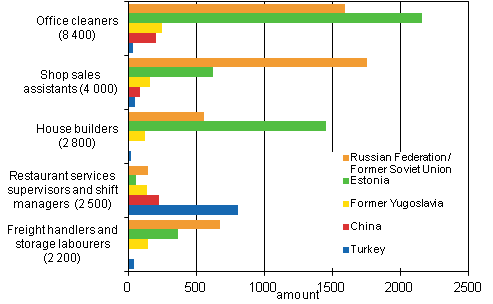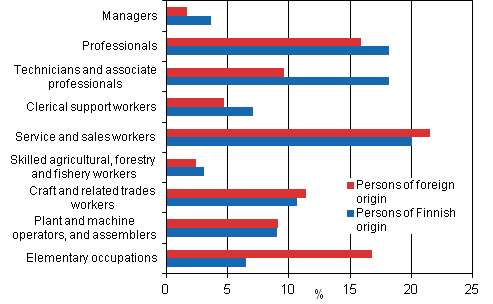Published: 6 November 2013
Every fifth office cleaner of foreign origin in 2011
Among persons of foreign origin, most worked as office cleaners measured in absolute numbers (some 8,400) in 2011, according to Statistics Finland's employment statistics. Other typical occupational groups for people with foreign background 1) were salespersons, building constructors, restaurant services supervisors and shift managers. A majority of office cleaners and building constructors with foreign background were of Estonian origin, while the most common background country for salespersons was Russia 2) and the most common background country for restaurant services supervisors and shift managers was Turkey. Approximately 84 per cent of restaurant services supervisors and shift managers of foreign background and some 16 per cent of building constructors were entrepreneurs.
Most common occupational groups of employed persons of foreign origin in 2011

The figure shows the five most common occupational groups and five largest background countries of employed persons of foreign background.
In 2011, there were a total of 101,300 employed persons of foreign origin and their share of all employed persons was around four per cent. Around 11 per cent or employed persons of foreign origin were self-employed. The highest proportion of self-employed persons was found among people with Turkish origin (40.2%). Among employed persons with foreign origin, 42 per cent were under the age of 35, which was ten percentage points higher than among employed persons of Finnish origin.
The highest number of employed persons with foreign background came from Russia and the area of the former Soviet Union, some 27,400. The next largest background countries based on the number of employed persons were Estonia (approx. 16,400 persons), former Yugoslavia (3,300), China (3,100) and Turkey (2,700). Among doctors of foreign origin, some two out of five were of Russian origin or from the area of the former Soviet Union. Approximately every other building constructor of foreign origin were of Estonian origin.
Relatively more persons of foreign origin compared to persons of Finnish origin worked as service and sales personnel, craft and related trades workers and under the section Elementary occupations of the Classification of Occupations (see figure below). In addition to cleaners, for instance freight handlers, orderlies, food preparation assistants and paper deliverers, couriers, etc. are included in Elementary occupations.
Occupational structure of employed persons by origin in 2011, %

At the 3-digit level of the Classification of Occupations 2010, managers were included in the ten most common occupational groups, for example, for persons with Turkish or British origin. Those with British origin worked as sales, marketing and development managers, while persons with Turkish origin worked as hotel and restaurant managers. There were several professional level occupational groups among the ten most common groups for persons with German or British origin. Persons of foreign background worked in professional occupations, for example as university and higher education teachers, systems specialists and doctors. Common occupational groups for several background countries were, for example, practical nurses, other healthcare workers and home helpers, as well as freight handlers and warehouse workers. (Appendix table 2.)
In Statistics Finland's employment statistics for 2011, the occupations of wage and salary earners and self-employed persons aged 18 to 74 according to their main employment relationship in the last week of the year have been classified according to the Classification of Occupations 2010. 3)
1) Here, persons of foreign background refers to the same thing as people of foreign origin. The concepts origin and background country are defined under Concepts and definitions.
2) Russia and the area of the former Soviet Union.
3) The data on occupations remained unknown for some 3.3% of all employed persons and for some 6.9% of employed persons of foreign origin.
Source: Employment Statistics, Statistics Finland
Inquiries: Elina Mikkelä 09 1734 2973, Marketta Oinonen 09 1734 3602, tyossakaynti@stat.fi
Director in charge: Riitta Harala
Publication in pdf-format (275.7 kB)
- Tables
-
Tables in databases
Pick the data you need into tables, view the data as graphs, or download the data for your use.
Appendix tables
- Appendix table 1. Most common occupational groups among employed persons aged 18 to 74 with foreign origin in 2011 1) (6.11.2013)
- Appendix table 2. Most common occupational groups among employed persons aged 18 to 74 with foreign origin in 2011 by background country 1) (6.11.2013)
- Appendix table 3. Employed persons aged 18 to 74, share of entrepreneurs among the employed and proportion of the unemployed among the labour force by background country in 2011 1) (6.11.2013)
Updated 6.11.2013
Official Statistics of Finland (OSF):
Employment [e-publication].
ISSN=2323-6825. Industry, employer sector and jobs 2011. Helsinki: Statistics Finland [referred: 22.9.2025].
Access method: http://stat.fi/til/tyokay/2011/04/tyokay_2011_04_2013-11-06_tie_001_en.html

